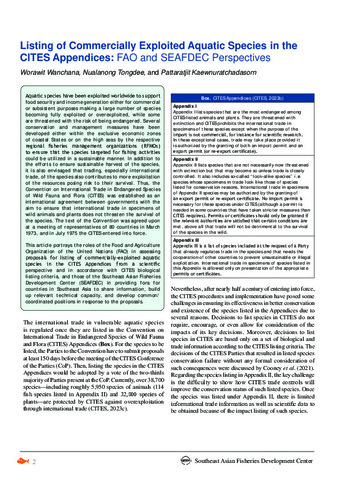| dc.description.abstract | Aquatic species have been exploited worldwide to support food security and income generation either for commercial or subsistent purposes making a large number of species becoming fully exploited or overexploited, while some are threatened with the risk of being endangered. Several conservation and management measures have been developed either within the exclusive economic zones of coastal States or on the high seas by the respective regional fisheries management organizations (RFMOs) to ensure that the species targeted for fishing activities could be utilized in a sustainable manner. In addition to the efforts to ensure sustainable harvest of the species, it is also envisaged that trading, especially international trade, of the species also contributes to more exploitation of the resources posing risk to their survival. Thus, the Convention on International Trade in Endangered Species of Wild Fauna and Flora (CITES) was established as an international agreement between governments with the aim to ensure that international trade in specimens of wild animals and plants does not threaten the survival of the species. The text of the Convention was agreed upon at a meeting of representatives of 80 countries in March 1973, and in July 1975 the CITES entered into force.
This article portrays the roles of the Food and Agriculture Organization of the United Nations (FAO) in assessing proposals for listing of commercially-exploited aquatic species in the CITES Appendices from a scientific perspective and in accordance with CITES biological listing criteria, and those of the Southeast Asian Fisheries Development Center (SEAFDEC) in providing fora for countries in Southeast Asia to share information, build up relevant technical capacity, and develop common/coordinated positions in response to the proposals. | en |

